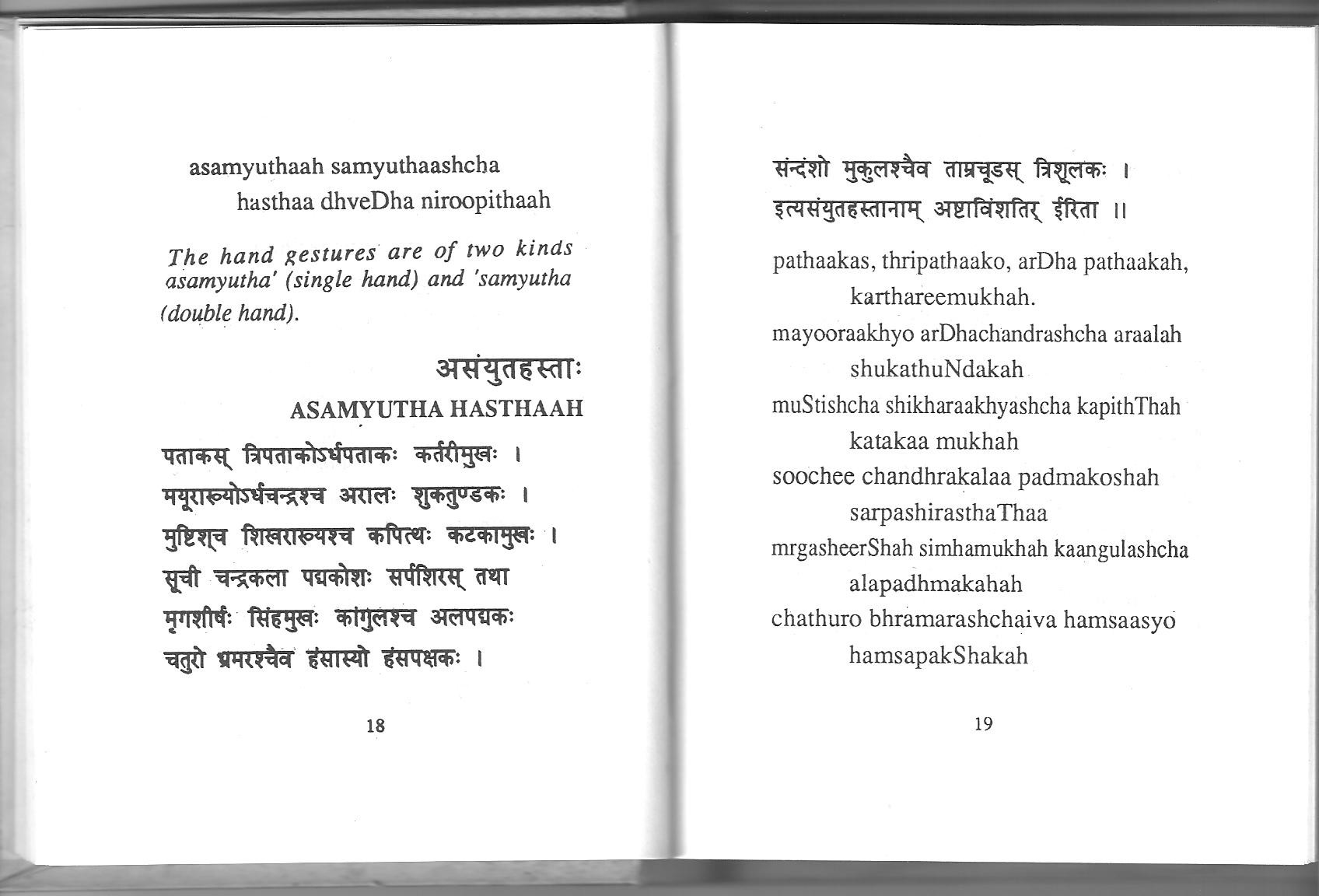
Asamyuta Hastas (Single Hand Gestures) :
- The list given below is from the Abhinaya Darpana.
- There are 28 single hand gestures.
- Pathaaka : Flag
- Tirupathaaka : To indicate a crown, lamp, Indra
- Ardha Pathaaka : To indicate a flagstaff, tower, river bank
- Karthari Muka - To indicate death, separation
- Mayura : To represent a peacock
- Ardha Chandra : To show the half moon
- Araala : To indicate blowing of wind
- Shukathundaka : To show shooting of an arrow or spear
- Mushti : To indicate firmness or a fight
- Shikara : To indicate a bow or pillar
- Kapitha : To show holding of flowers, holding of cymbals by artistes
- Katakamukha : To indicate collecting of flowers
- Suchi : To indicate number one or supreme soul
- Chandra Kala : To show the Moon
- Padma Kosha : To show a flower bud or fruit
- Sarpa Shirasa : To show a snake
- Mriga Shirsha : Used to denote a woman, face of a deer, welfare of all
- Simha Mukha : To show face of a lion, rabbit, sacred occasion
- Kangula : To show a coconut, small bells or betelnut
- Alapadma : To show a full bloomed lotus
- Chathura : To indicate little quantity, slow movement
- Brahmara : To show a bee
- Hamsasya : To indicate auspiciousness, pearls, painting or drawing
- Hamsapaksha : To indicate number six or a bridge
- Sandamshu : To indicate fear, the number five or a wound
- Mukula : To indicate eating or a flower
- Thamrachooda : To show a cock, crane, crow
- Thrishoola : To indicate the trinity (Brahma, Vishnu, Shiva)
Shloka for Asamyuta Hasta :
Pathakas thripathaako ardhapathaakaha karthareemukhaha
mayooraakhyo ardhachandrashcha araalaha shukhatundakaha
mushtishcha shikharaakhyashcha kapithaha katakaamukhaha
soochee chandrakalaa padmakoshaha sarpashirasthathaa
mrigasheershaha simhamukha kaangulashcha alapadmakaha
chathuro bhramarashchaiva hamsaasyo hamsapakshakaha
sandamsho mukulashchaiva thaamrachoodas thrishoolakaha
ithyasamyutha hasthaanaam ashtaa vimshathireerithaa

Samyuta Hastas (Double Hand Gestures) :
- The list given below is from the Abhinaya Darpana.
- There are 23 double hand gestures
- Anjali : Salutation
- Kopotha : Accepting something respectfully
- Karkata : To show a group or blowing of a conch
- Swastika : To show a crocodile, sky, ocean or vast expanse
- Dola : To be used in the beginning of a dance
- Pushpaputa : Offering of flowers
- Utsanga : To show embrace
- Shivalinga : To show Shiva Linga
- Katakavardhana : To show coronation, worship and marriage
- Karthariswastika : To show trees, branches
- Shakata : To show large eyes, usually used with demons
- Shanka : Conch
- Chakra : Disc
- Samputa : Box or secret
- Pasha : Enemy, Quarrel
- Kilaka : Friendhip
- Matsya : Fish
- Koorma : Turtle
- Varaaha : Boar
- Garuda : Eagle
- Nagabandha : To show intertwined serpents
- Khatva : Bed or palanquin
- Berunda : Pair of birds
Shloka for Samyuta Hasta :
anjalishcha kapothashcha karkatas svasthikasthathaa
dolahastaha pushpaputa utsangaha shivalingakaha
katakaavardhanashchaiva kartharee svasthikasthathaa
shakatam shankha chakre cha samputaha paashakeelakau
mathsyaha koormo varaahashcha garudo naagabandhakaha

Dhyana Shloka :
Stand in attention, with hands in Namaskar and recite before you begin dance.
Aangikam Bhoovanam Yasya Vaachikam Sarva Vaangmayam
Aaharyam Chandra Thaaraadi Tham Numa Saatvikam Shivam
Meaning :
Shiva’s body is the entire universe
His speech is the language of the universe
His ornaments are the moon and the stars
Him we worship, the serene Lord Shiva
Important Rule for Dance :
Yetho Hasta Thatho Drishti
Yetho Drishtis Thatho Manah
Yetho Manas Thatho Baavo
Yetho Baavas Thatho Rasah
Meaning:
Wherever the hand goes the eyes follow
Wherever the eyes go the mind follows
When the mind is engaged, expression results
Where there is expression, there is beauty
- Abhinaya Darpana, Shloka No. 247



